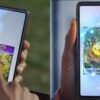In the second Treehouse event at E3, Nintendo and mobile developers Niantic have dropped fresh new info on their highly anticipated mobile game, Pokémon GO.
With only minimal news about the game in recent months, fan speculation was through the roof on how the game would play and what could be done. But during a Q&A with key developers and field testers of the game, our fears were put to rest with some vital information about the mobile game which uses location data to allow players to capture Pokémon on their phones.
Initially starting as part of an April Fools joke with Google, developers at Niantic and Nintendo gathered together to assess the reality of bringing the project to life, piggybacking off the success of Niantic’s previous game, Ingress.
Playtesters have averaged throwing 30 Pokéballs per second while playing, as well as enjoying capturing Pokémon in places they know. Glimpses of the app were shown, including info as to where Pokémon were caught and capture totals. Images of overlaid maps and areas were also displayed, as well as music and sound effects to accompany it.
The aspect of raising Pokémon has changed slightly from the core gaming mechanic, with less of a focus on battling to train, and a ‘candy’ mechanic suggested as a means to allow Pokémon to grow instead. Trading will be implemented further down the track, but not available immediately at release.
So far, many field testers have only seen Kanto-based Pokémon in certain locations, but the developers have stated they wish to bring the game to a point where you are available to capture them all; with Kanto Pokémon to celebrate the 20th Anniversary of Pokémon. Using location tagging, mapping certain Pokémon to different areas in order to get players to explore bigger areas is a key focus for the game.
The Pokémon GO Plus unit was revealed on-stage as well; a Bluetooth-connected peripheral that allows players to play Pokémon GO without having to look at the phone itself, allowing players to fully explore their environments without being engrossed by their mobile screens. Sharing the typical Poké Ball imagery, the unit has lights that alert players to nearby Pokémon, and the button on the device allows players to capture the monster without having to look up. However capturing monsters this way is not a guaranteed success, with the lights changing depending on status. The device is hoped to be released by the end of July, but no date is set in stone as of yet – devices will be available through certain retailers, identified through the app. US pricing is at $34.99
Connectivity between Pokémon GO and Pokémon Sun and Moon was suggested but not revealed, with developers hoping to implement it in the future.
Pokémon GO has not been given a release date, but will release prior to the Plus unit that has been announced.
Stay tuned for more details.



